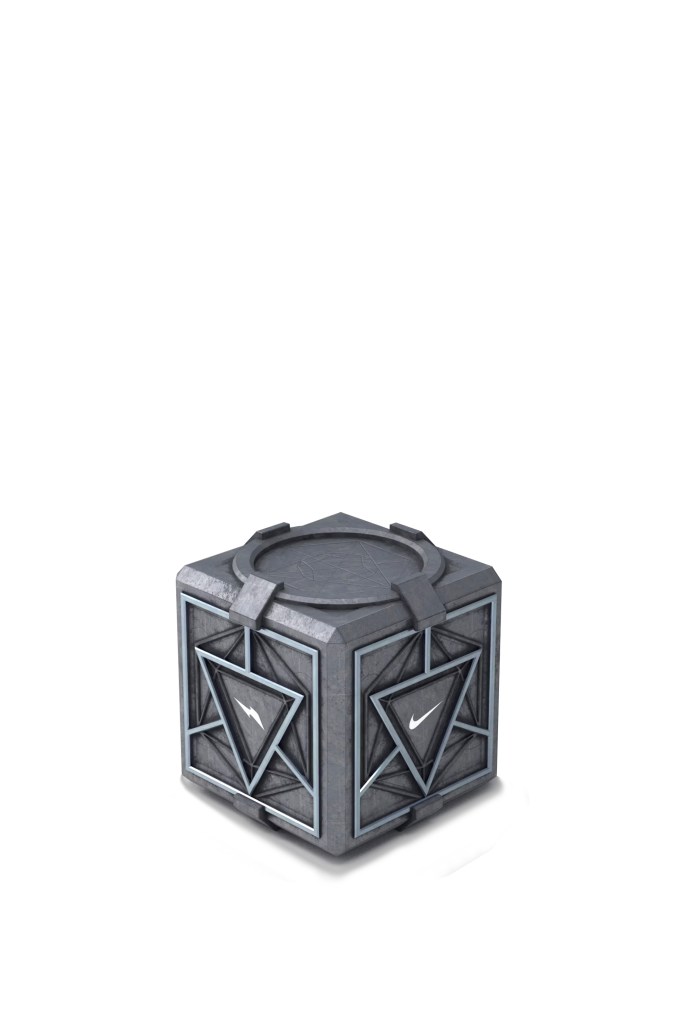Two years ago, non-fungible tokens were sizzling hot as art lovers and speculators pushed blockchain-based images to US$27 billion in value. Now that the market has crashed, much less ambitious versions of NFTs are finding a welcome home in the marketing departments of corporate America.

IN THE FIRST WEEK of October, 2023 non-fungible token (NFT) trading fell to its lowest weekly level since 2020, according to data from TheBlock, with only US$50 million worth of digital collectibles exchanged on secondary markets. It was a bleak month for NFTs, whose trading volume plummeted from a record US$3.2 billion a week in 2022 as prices slid to fractions of their crypto-boom highs.
The tepid activity came two weeks before Nike planned to sell more than 30,000 pairs of its popular Dunks sneakers in a collection linked to NFTs, with an increasingly popular twist that allowed non-blockchain buyers to get in on the action. Unlike virtually all of the previous efforts, buyers could pay by credit card instead of cryptocurrency, snagging a custom-sized pair of Dunks in one of three colour combinations: white and blue, black and purple and black and red.
Appealing to its traditional youthful buyers worked out for Nike, with the sale bringing in US$7 million, or an average of about US$230 a pair, and each Dunk owner would own a digital version of the sneaker on the Ethereum blockchain. It’s a release model that has proven to be a useful marketing manoeuvre – in August 2022, Nike offered a 10-piece leisure apparel collection through its CloneX NFT line. The Beaverton, Oregon company, famous for its long relationship with Michael Jordan, has been selling NFT-related apparel since December 2022, when it released the auto-lacing CryptoKicks iRL collection of sneakers. Pieces from that inaugural offering that sold for about US$900 can now fetch up to US$3,000 on sneaker resale sites like StockX.
The Dunk Genesis collection “was a huge success,” says Steven Vasilev, co-founder of NFT studio RTFKT (pronounced “Artifact”), which Nike purchased in December 2021. “Even though the market is still down, our products are still bringing in new people.”
Non-fungible tokens are created, bought and sold on blockchains, like cryptocurrencies such as bitcoin and ether. But while each currency’s tokens are alike, every NFT is unique and can reward users with various perks or be linked to objects in the real world. They can also be traded on numerous secondary markets like OpenSea.
The NFT landscape has drastically shifted in the two years since the tokens became part of mainstream art and pop culture. Barely more than a year ago, CryptoPunks, a collection of thousands of pixelated headshots and the cartoon simians of Bored Ape Yacht Club, commanded multi-million-dollar price tags at auction. Now, the most expensive rarely trade for over US$100,000. NFTs selling for over US$10 million disappeared last year, and companies born out of NFT collections, like Rektguy and Bored Apes purveyor Yuga Labs, are struggling to pivot their business models away from royalty payments generated by secondary sales. The overall market shrank to US$9.5 billion in revenue last year from US$26.7 billion in 2022, according to CryptoSlam. Emerging from the aftermath of the NFT craze are major companies embracing the tokens as a cutting-edge marketing device, helping them get closer to existing customers and woo new ones.

While earning meaningful revenue or profit is a long way off, corporate America is finding useful ways to employ unique blockchain-based tokens in their marketing arsenals.
Some companies like Nike are incorporating NFTs into their products, bringing virtual images to physical reality. Credit card giant Mastercard partnered with crypto neobank Hi to allow NFT users to showcase their NFTs on plastic cards in their wallets.
“The card designs and cards you use for payment reflect who you are,” says Christian Rau, head of Mastercard’s crypto and fintech operations in Europe when the partnership launched in October 2022. Digital art on a credit card “basically allows consumers to display a physical manifestation of an NFT they care about.”
Beyond physical branding, others have included blockchain elements into existing marketing strategies. In June 2023, Coca-Cola added NFTs to its global Masterpiece advertising campaign, in which the company’s iconic red-and-black bottles were passed around by animated versions of well-known artworks like Edvard Munch’s The Scream and Vincent Van Gogh’s Bedroom in Arles. In August, the company launched a series of digital artworks on Coinbase’s Base blockchain that put combinations of famous paintings and contemporary works onto its bottles in a series of digital images linked to NFTs. Coca-Cola’s drop brought in US$543,000 from the sale of 80,000 tokens.
The virtual tactic taps into the existing markets of Coca-Cola superfans and vintage container collectors, some of whom are willing to spend up to US$4,000 at auction for the rarest bottles. In comparison, Coke’s NFTs allowed collectors to buy in for US$25 worth of ether to collect at the time of the August 2023 sale.

Some companies are using NFTs to breathe new life into their loyalty programs. Starbucks, for example, launched a test version of its Odyssey loyalty program in December 2022, giving a select group of users access to online games and quests that generate NFT rewards. The tokens offer holders exclusive programs, including bonus Starbucks stars (the company’s loyalty points), access to specialty drinks, online cocktail-making classes and vacations.
Rewards are already coming in for existing Odyssey members. The top 20 points holders as of January 2024 will be invited to go on an all-expense paid trip to Costa Rica, where Starbucks owns its only coffee farm.
Germany’s Lufthansa has taken a similar approach to loyalty, delivering commemorative NFTs for certain trips or destinations to users of the airline’s Uptrip platform, acting somewhat like digital stamps for passengers’ digital wallets. The service creates NFTs on the Polygon blockchain that can be redeemed for free in-flight WiFi and access to airport lounges and airline miles.
This kind of loyalty program does not need to rely on blockchain technology to run, but using it could make it cheaper; plus, it gives Lufthansa’s customers the impression that the company embraces the latest tech. “Companies can have many of the tools of a loyalty program without building as much infrastructure,” says Paul Brody, global blockchain lead at consulting firm Ernst & Young. The goal of these collectibles is largely to keep users loyal to the issuing company, trading is discouraged.
“It can turn out to be really great advertising. Your blockchain wallet will become a bit like your public trophy case.”
Still, Brody says, “It can turn out to be really great advertising. Your blockchain wallet will become a bit like your public trophy case.”
The biggest hurdle companies may face is in marketing. Getting hold of NFTs often includes adding browser extensions, obtaining a crypto wallet, creating lengthy passwords and transacting in digital currencies like ether, which can be daunting for the uninitiated.
That is part of the reason Nike’s Vasilev avoids the term NFT. It is also why RTFKT added an option to buy the physical sneakers first (without the NFT) using traditional credit card payment options instead of crypto. Doing so in the Dunk Genesis drop brought in new customers, Vasilev says, as 93% of buyers who bought the physical sneakers before the NFTs were first-time customers of RTFKT products. “We think this is a huge way to onboard new people,” he adds.
Sneaker companies may represent the perfect marriage of NFT technology and brand marketing,because top brands already cultivate young buyers via an active collectibles market. Adidas and Puma are launching blockchain-compatible collections.
Adidas has combined physical and digital approaches to using NFTs. Last year, it partnered with Japanese streetwear brand BAPE to release a limited 100-pair edition of virtual white sneakers that could be used to buy the physical counterpart. In partnership with MoonPay, a crypto payment platform, users bid on the 100 items for 72 hours before collecting their digital pair. Each NFT was tradeable, but they could also be redeemed for Adidas’ Forum Low 84 sneakers in an exclusive colour pattern for holders willing to burn or destroy the NFT. The highest bid for a single pair of sneakers was almost US$4,000, according to Etherscan.
Puma has adapted strategies used by both of its rivals. After experimenting with made-to-order sneakers for physical versions of an NFT collection it released in 2022, it pivoted to first selling tokens that could be redeemed for limited edition versions of an existing running shoe called Fast-RB. For now, however, it focuses on its Puma Pass, a token that gives users early access to NFT collections and digital wearables for gaming platforms.
“Just creating a profile picture collection or a loyalty program is low-hanging fruit,” says Ivan Dashkov, head of emerging technologies at Puma. “You need to think of new, novel ways to use [blockchain] technology to interact with your customer.”
The use of NFTs as a marketing tool is still in its infancy. Almost no existing corporate marketing program has taken steps to implement permanent NFT programs, says Brody.
The emphasis is on experimentation and consumer use. As trading on once-sizzling hot marketplaces like OpenSea continues to languish, no one is talking about the secondary market for NFTs.
“We’re headed for a future that is more and more NFTs as souvenirs and as public trophies and not as transferrable financial assets,” says Brody.
Forbes Australia Issue 9 is out now. Tap here to secure your copy.



